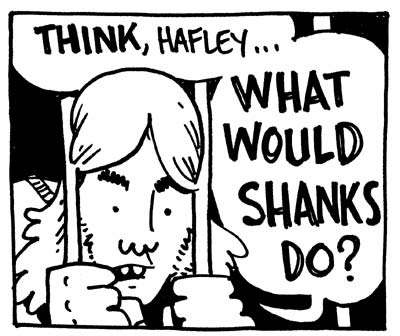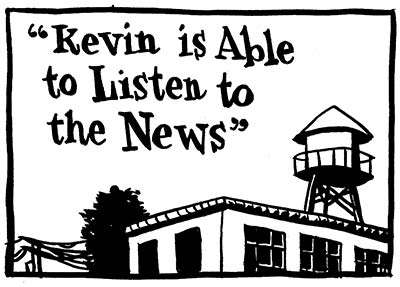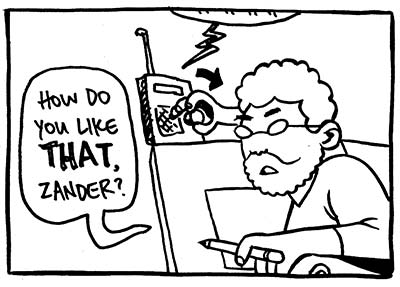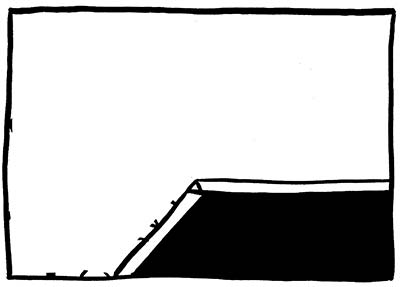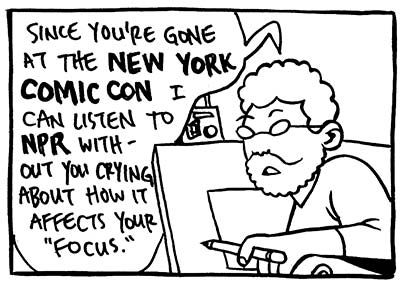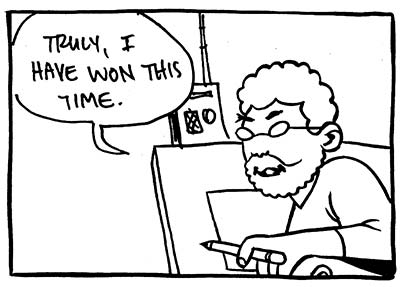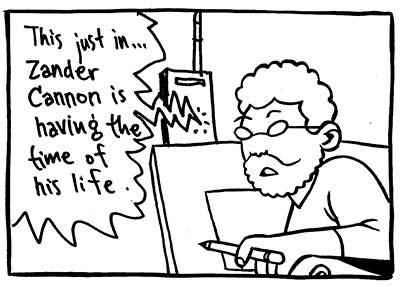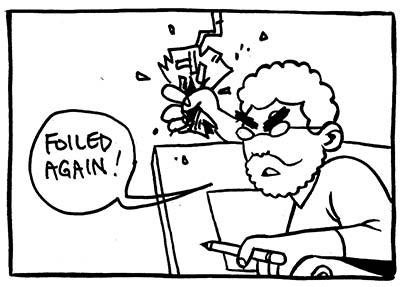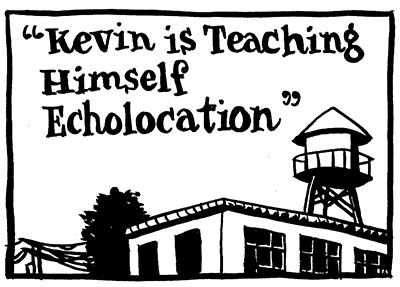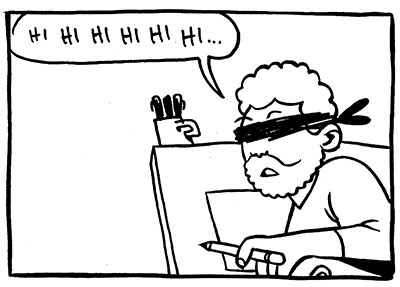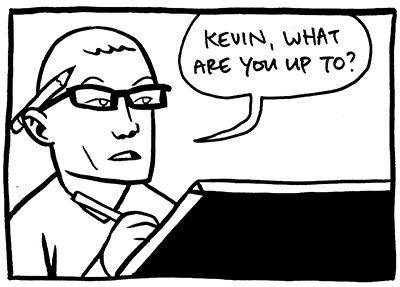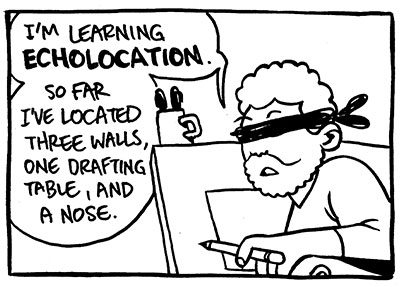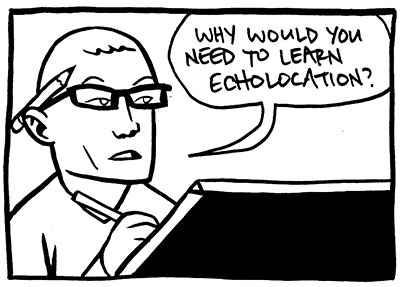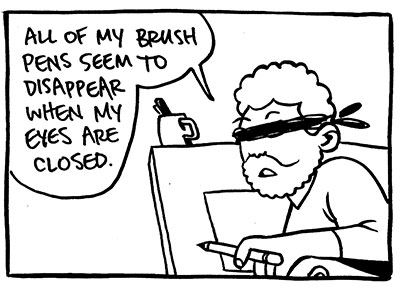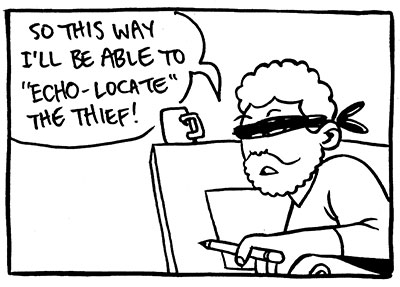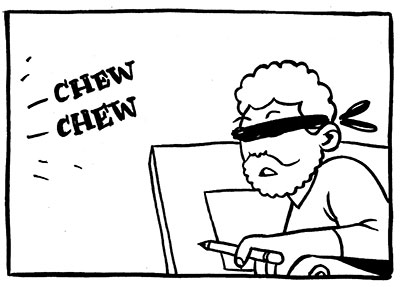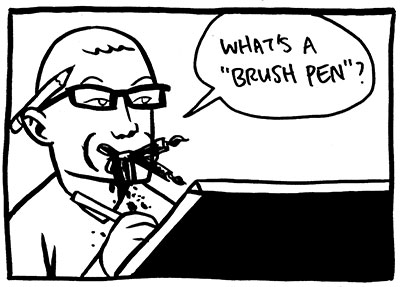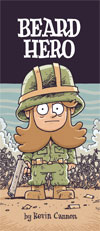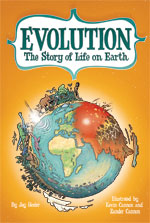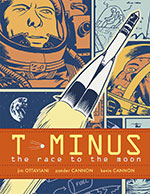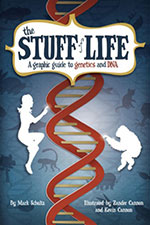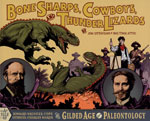Have you ever thought about an invention that maybe YOU can't make, but it sure would be nice if someone else did?
No, I didn't stutter, I wish someone would invent a decent e-economy. That is, a way to buy and sell information on the internet that doesn't involve any physical media for a decent price. It's not too bad at the moment. iTunes is as good a way of buying music as any, I guess. It's better for TV shows and movies. I mean, a 48-minute TV show costs $1.99. A 3-minute song costs $.99. Come on! I don't blame Apple-- I know that the music industry has given them weird mandates that they can't really get around at the moment. But the problem with the e-economy as it exists now is that things cost way too much considering how little things cost to distribute and package as opposed to their real-world counterparts. But more to the point, it's too expensive considering how much people want to pay.
We've gotten past all serious talk of micropayments, apparently, especially with Bitpass going under. Bitpass was the first real payment system that allowed vendors to charge small amounts-- as small as a dime-- and they sold Scott McCloud's The Right Number for a quarter per chapter. The Right Number had chapters of about, say, 100 panels each: approximately what you'd have in a regular comic. I jumped at that because I'd been waiting for more McCloud stuff, and I was eager to see his philosophy jump to the mainstream-- the philosophy that large amounts of information should cost small amounts of money. But my thought was that it was a little expensive. It sounds strange to say, since obviously 25 cents is a very small amount of money, but really, 100 panels of free comics online is not exactly a rarity. Far Arden, just to choose an example. So I got it, and it was good (so far-- there's a third chapter that hasn't been done yet), but nothing about the transaction struck me as anything other than proof of concept.
I had some extra money on my BitPass account after that purchase, so I looked around for some other vendors that accepted it. One that interested me was called Dime Novels. A novel for a dime? Wonderful! I'll take it! But the thing was-- they weren't novels. They weren't even novellas. They were about ten pages long. With all the free stuff online and all the great content that people are putting up just for the heck of it, these were a total ripoff. If someone put up a hundred-page novel and charged a quarter for it, I'd get it just to see what it was about. I might not even read the whole thing if it wasn't that great, but I'd never feel like I'd wasted my money. The problem with these products is basically that they failed the sniff test. Does something seem like a great deal? Then people will buy it. Does it seem like it's barely worth it? They won't. 25 cents for a Scott McCloud comic is worth doing once or twice, but I'd start to feel like I was just throwing money away after a half-dozen, even if it wasn't that much money.
A lot of the talk about micropayments was about things like charging a tenth of a cent for a daily comic strip, but to me, that sort of thing just sounded like it would make a good portion of the web a giant pain in the neck. I liked the idea of charging a quarter for a LOT of content, rather than an infinitesimal amount of money for five seconds of entertainment.
Some people bristle at the idea of paying anything for content on the web, and I certainly understand that. There is the feeling that nothing is free anymore, and that browsing anything is a commitment. But I think that if vendors understand that they are competing with huge amounts of quality free material, they would quickly price themselves at a reasonable rate. Little things, like daily strips, would not last long as a paid commodity. But five years of that comic strip in a convenient file format for a quarter sounds like a pretty good deal. The money spent would simply be a small fee for not having to search the whole internet with a peer to peer client.
There are a lot of things to be had online that are not 100% legit that, if they were packaged inexpensively, and I mean REALLY INEXPENSIVELY, could be sold by the creators and copyright holders. One hundred issues of old X-Men comics in pdf format? One dollar. Fifty old-school arcade game ROMs? Five cents. All the Philip Marlowe radio dramas? Buck fifty. A Doc Savage novel? A dime.
It would take some experimenting to find that sweet spot where you're not just giving it away, and still attracting customers, and one might have to find some solutions for bandwidth (like BitTorrent), but isn't that the purpose of an economy? If those things are so readily available for so little money, who (in large numbers) would look for them illegally, except out of sheer cussedness? And (particularly in the examples I've given) if the material is old and out of print, there is little to keep publishers from putting it out there. In most cases they're not making money off it anyway.
Online payment systems, like PayPal, shouldn't have any barriers to transferring small amounts of money from one PayPal account to another-- it's just moving bits-- and charging a small percentage of the price as a transaction fee.
I mean, think about it. What are some big things you'd pay a dollar for?
Scott McCloud's micropayment comic and micropayment essay
Sean Barrett's "upay" response
Wednesday, February 28, 2007
Tuesday, February 27, 2007
Cartooning Tips and Tricks: The 5 Purposes Of Panels
Every book about comics has a discussion about the different types of panels, and they're usually pretty self-explanatory. Wide shot, medium shot, head and shoulders, half figure, two-shot, close-up, extreme close-up, etc. Those are useful for giving someone the sense for how far away to place their "virtual camera" in order to get all of the things in the shot that are necessary. But when I think about panels, I like to think about what they accomplish instead of where you're looking from. So I basically break down my panels into 5 types, according to how they drive the story.
Relative Position
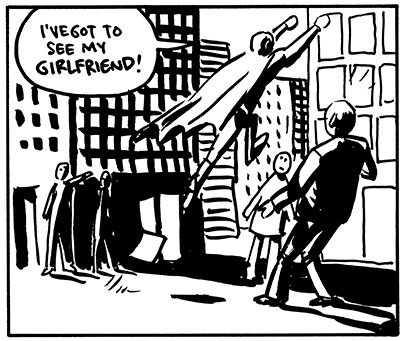
One of the most important things a panel can do in a comic, particularly a comic that has a lot of action, is define the relative positions of characters, or a character and a prop, or two elements of the background, etc. Usually these panels are pretty unemotional and wide, so that we can really tell, for instance, how far apart two kung-fu fighters are standing. It will do little to show their emotions, however, and a comic that has too many of these types of panels will, in total, seem to be physically exciting, but may lack a certain emotional depth. Like, the hero beat up all the henchman, and threw the switch that blew up the evil king's tower, but none of it seems like any of your business.
Emotion
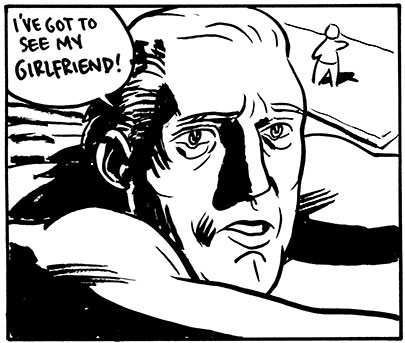
You would not be too far off to think of these mostly as close-ups of people's faces. We tend to look at the face as the main way to determine how someone is feeling. But a wide shot of someone alone as a car is pulling away or a close-up of a clenching fist also serve the purpose of making us aware of the character's emotions. Rendering and coloring style has a great deal to do with how these panels come across; certain dynamic style choices can also add to the emotion of a panel. Adding striations to muscles or speed lines or even flying sweat drops add a subjectivity to the panel that can give it a little emotional weight. A story with too many emotion panels will often seem a little cramped, and will sometimes lose a sense of being in a real world, and have a dreamlike quality to it that makes points of the plot seem meaningless.
Detail
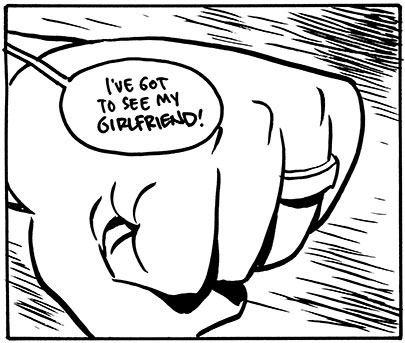
Where Emotion panels are often closeups, so are Detail panels, but they usually concern plot elements rather than emotional ones. A shot of the map that the treasure hunters are following. A shot of a someone's name coming up on Caller ID. A detailed close-up of a clue in a murder mystery. These tell us about the intricacies of the plot. A story with too many of these will seem overly nitpicky and distant. You will also wonder if there are any people in the story.
Scale
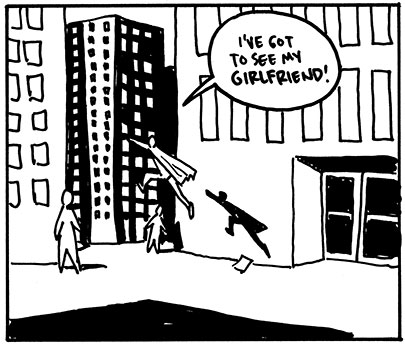
When I have a large panel, I like to make sure that I use it to communicate Scale. If you're telling a long, intricate story, you don't always have a lot of big panels to spare, so it's nice to use them for something that small panels just can't do very well. Sometimes it's nice to show that Superman is just a speck against those skyscrapers he flies past. Or that Godzilla is as big as a mountain.
Establishing Shot
This is the one that everyone already knows. I almost didn't include it because it conjures up such a standard image in everyone's mind: a wide shot of the exterior of a building. So boring. But an establishing shot can be anything that immediately puts you into the time and place of a scene. And it can use most of the preceding panel types. If someone says, "Let's go somewhere and talk" and the next shot is a close up of a coffee cup, someone's hands and an empty sugar packet (a Detail), you know they're in a coffee shop. An establishing shot can also take place in the middle of a scene. Example: Two swordsmen are dueling, and the bad guy is pressing the good guy over the edge of a parapet. The good guy suddenly rallies and kicks the bad guy down some stairs. With a change of location like that, you'll probably want to cut to a establishing shot to show where these two fighters are in relation to each other (their Relative Position). Even the classic big establishing shot of a building's exterior is often one that communicates Scale by showing how large a building, or castle, or spaceship, is. Overall, the effect is that we know where we are so that we can begin or continue a scene. Sometimes, using several Emotion panels instead of an establishing shot will leave the reader so hungry for information about where the action is taking place that they will pay particular attention to what is being said.
Though these purposes of panels are independent of the panel size, they do tend to lend themselves to certain usages. When I have a large panel, I like to use it to define Scale as well as anything else. When I have a series of small panels, I like them to be at least partially devoted to Emotion or Detail. Wide shallow panels in a sequence are good to reestablish Relative Position if it has changed during the scene.
The main thing is that a panel should always accomplish at least one of these purposes, or it risks looking dull and pointless. Every time a panel seems like it isn't working, it's good to think about these five types and make sure that at least one is in evidence-- if not, you have a starting point for fixing it.
For more about panels, there's Wally Wood's 22 Panels That Always Work. Another take on it from Scott McCloud's Understanding Comics is the 5 types of panel transitions.
The 5 Purposes Of Panels

One of the most important things a panel can do in a comic, particularly a comic that has a lot of action, is define the relative positions of characters, or a character and a prop, or two elements of the background, etc. Usually these panels are pretty unemotional and wide, so that we can really tell, for instance, how far apart two kung-fu fighters are standing. It will do little to show their emotions, however, and a comic that has too many of these types of panels will, in total, seem to be physically exciting, but may lack a certain emotional depth. Like, the hero beat up all the henchman, and threw the switch that blew up the evil king's tower, but none of it seems like any of your business.

You would not be too far off to think of these mostly as close-ups of people's faces. We tend to look at the face as the main way to determine how someone is feeling. But a wide shot of someone alone as a car is pulling away or a close-up of a clenching fist also serve the purpose of making us aware of the character's emotions. Rendering and coloring style has a great deal to do with how these panels come across; certain dynamic style choices can also add to the emotion of a panel. Adding striations to muscles or speed lines or even flying sweat drops add a subjectivity to the panel that can give it a little emotional weight. A story with too many emotion panels will often seem a little cramped, and will sometimes lose a sense of being in a real world, and have a dreamlike quality to it that makes points of the plot seem meaningless.

Where Emotion panels are often closeups, so are Detail panels, but they usually concern plot elements rather than emotional ones. A shot of the map that the treasure hunters are following. A shot of a someone's name coming up on Caller ID. A detailed close-up of a clue in a murder mystery. These tell us about the intricacies of the plot. A story with too many of these will seem overly nitpicky and distant. You will also wonder if there are any people in the story.

When I have a large panel, I like to make sure that I use it to communicate Scale. If you're telling a long, intricate story, you don't always have a lot of big panels to spare, so it's nice to use them for something that small panels just can't do very well. Sometimes it's nice to show that Superman is just a speck against those skyscrapers he flies past. Or that Godzilla is as big as a mountain.
This is the one that everyone already knows. I almost didn't include it because it conjures up such a standard image in everyone's mind: a wide shot of the exterior of a building. So boring. But an establishing shot can be anything that immediately puts you into the time and place of a scene. And it can use most of the preceding panel types. If someone says, "Let's go somewhere and talk" and the next shot is a close up of a coffee cup, someone's hands and an empty sugar packet (a Detail), you know they're in a coffee shop. An establishing shot can also take place in the middle of a scene. Example: Two swordsmen are dueling, and the bad guy is pressing the good guy over the edge of a parapet. The good guy suddenly rallies and kicks the bad guy down some stairs. With a change of location like that, you'll probably want to cut to a establishing shot to show where these two fighters are in relation to each other (their Relative Position). Even the classic big establishing shot of a building's exterior is often one that communicates Scale by showing how large a building, or castle, or spaceship, is. Overall, the effect is that we know where we are so that we can begin or continue a scene. Sometimes, using several Emotion panels instead of an establishing shot will leave the reader so hungry for information about where the action is taking place that they will pay particular attention to what is being said.
Though these purposes of panels are independent of the panel size, they do tend to lend themselves to certain usages. When I have a large panel, I like to use it to define Scale as well as anything else. When I have a series of small panels, I like them to be at least partially devoted to Emotion or Detail. Wide shallow panels in a sequence are good to reestablish Relative Position if it has changed during the scene.
The main thing is that a panel should always accomplish at least one of these purposes, or it risks looking dull and pointless. Every time a panel seems like it isn't working, it's good to think about these five types and make sure that at least one is in evidence-- if not, you have a starting point for fixing it.
For more about panels, there's Wally Wood's 22 Panels That Always Work. Another take on it from Scott McCloud's Understanding Comics is the 5 types of panel transitions.
Sunday, February 25, 2007
Friday, February 23, 2007
Influences at the New York Comic-Con 2007
Zander says: I'm at the New York Comic-Con this weekend, and I'll be updating with cell phone pictures of my influences that I meet at this show. The accompanying text will be brief, as I will be typing it on a numeric keypad.
Thanks to Kevin, who's posting all of these as I send them to him.
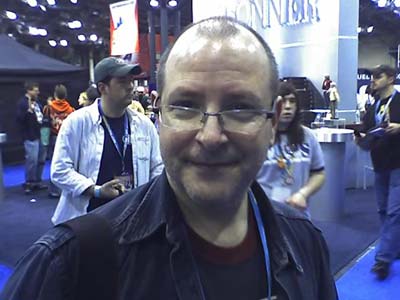
Mike Mignola
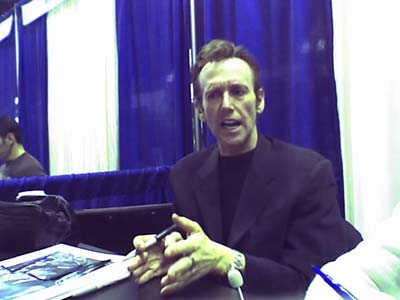
Bill Sienkiewicz

Jon Bogdanove

David Mazzucchelli
David Mazzucchelli is by far my biggest influence in the realm of storytelling-- I'd never met him until this convention. And meeting him made up for every hero of mine that turned out to be a dud or a jerk or who was too busy to talk. He was one of the nicest, most accommodating people I'd ever met, and articulated his thoughts on storytelling and illustration with an unpretentious air. He said that he had nearly finished a 300 page graphic novel, which makes me a little lightheaded thinking about it.
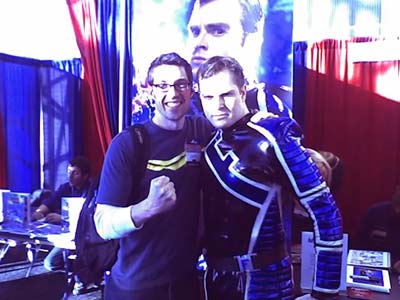
Feedback!

Kevin Maguire
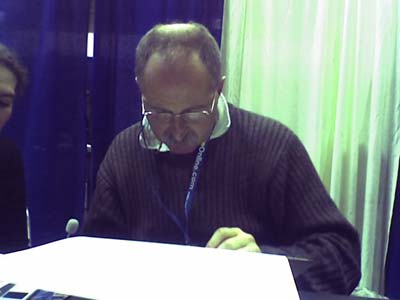
Brian Bolland
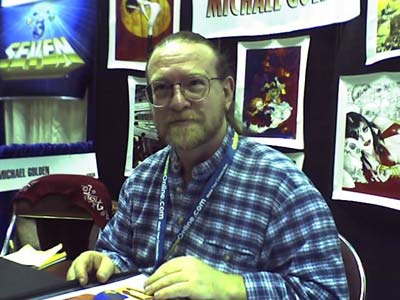
Michael Golden
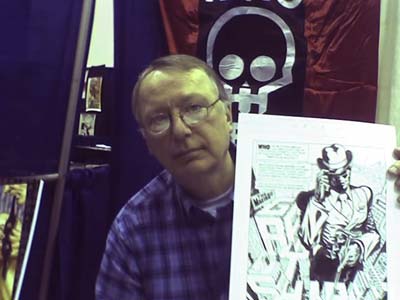
Rick Veitch

Jose Luis Garcia-Lopez

Rob Walton of 'Ragmop'
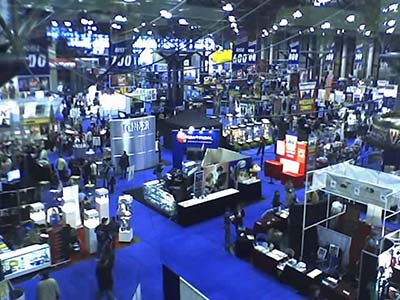
The show floor
Thanks to Kevin, who's posting all of these as I send them to him.

Mike Mignola

Bill Sienkiewicz

Jon Bogdanove

David Mazzucchelli
David Mazzucchelli is by far my biggest influence in the realm of storytelling-- I'd never met him until this convention. And meeting him made up for every hero of mine that turned out to be a dud or a jerk or who was too busy to talk. He was one of the nicest, most accommodating people I'd ever met, and articulated his thoughts on storytelling and illustration with an unpretentious air. He said that he had nearly finished a 300 page graphic novel, which makes me a little lightheaded thinking about it.

Feedback!
Feedback (Matthew Atherton) and I went to Grinnell College together in the 90s-- in fact, we met as prospective students while visiting the campus. He was obsessed with Spider-Man then, and would appear in full costume at practically every public event. He particularly liked cartwheeling into the dining hall on Parents' Weekend. Our senior year, he and I made mysteries for each other to solve (in costume, and often involving talking to professors at home), which he mentions on the "Who Wants To Be A Superhero?"

Kevin Maguire

Brian Bolland

Michael Golden

Rick Veitch

Jose Luis Garcia-Lopez

Rob Walton of 'Ragmop'

The show floor
Thursday, February 22, 2007
Chapter 99: Versus
IN THIS CORNAH-- The fightin' continues as Zander Cannon returns with his hillbilly grappler "Big Boy" Barnabas Rutledge to challenge Don't-Write-Checks-Your-Derriere-Can't-Cash Tim Sievert's trickster incarnate Ronnie "The Iceman" Colwell!
Just click on the picture below to start the mayhem.
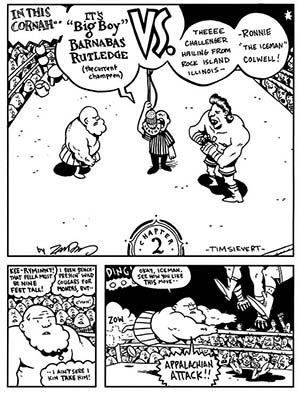
* Click for Larger Image *
Just click on the picture below to start the mayhem.

* Click for Larger Image *
Wednesday, February 21, 2007
I Wish Someone Would Invent: The HamsterCopter
Have you ever thought about an invention that maybe YOU can't make, but it sure would be nice if someone else did?
For far too long, our furried friends the hamsters have been trapped to the ground -- due to gravity, to be sure, but also due in part to humanity's lack of creativity when designing recreational vehicles for said hamsters. A clear plastic ball that rolls around on the floor? Okay, that was fun for awhile. But if I know hamsters, they want to be soaring with bald eagles, not pushing around dust bunnies.
This is where the HamsterCopter comes in. Strap in your little guy and watch him have the time of his life.
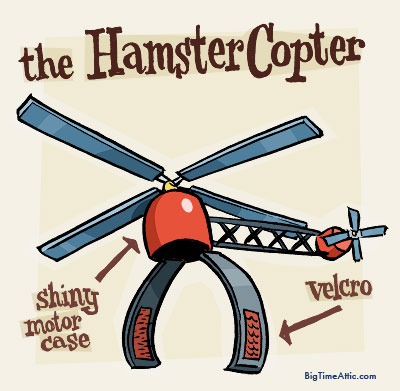
Since hamsters don't have a boredom gene, they can have a great time up there for days. You, however, might start yawning after the first few hours, so here are some games you can play with your pal:
* Dodge-a-Hawk
* Raze the Roof!
* The Eyes Closed Game
* Nose Dive Recovery
* Water Landing
* Spoon and Hamster Race
* How Wide is the Middle of That Tire Swing?
Happy Flying!
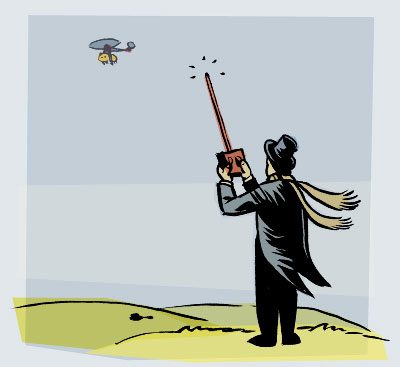
So, you want to invent it? Already know about something just like it? Got a reason why it would never work? Got some suggestions? Got your own "I Wish Someone Would Invent..."? See you in the comments!
For far too long, our furried friends the hamsters have been trapped to the ground -- due to gravity, to be sure, but also due in part to humanity's lack of creativity when designing recreational vehicles for said hamsters. A clear plastic ball that rolls around on the floor? Okay, that was fun for awhile. But if I know hamsters, they want to be soaring with bald eagles, not pushing around dust bunnies.
This is where the HamsterCopter comes in. Strap in your little guy and watch him have the time of his life.

Since hamsters don't have a boredom gene, they can have a great time up there for days. You, however, might start yawning after the first few hours, so here are some games you can play with your pal:
* Dodge-a-Hawk
* Raze the Roof!
* The Eyes Closed Game
* Nose Dive Recovery
* Water Landing
* Spoon and Hamster Race
* How Wide is the Middle of That Tire Swing?

So, you want to invent it? Already know about something just like it? Got a reason why it would never work? Got some suggestions? Got your own "I Wish Someone Would Invent..."? See you in the comments!
Tuesday, February 20, 2007
PUNY drawing presentation TONIGHT
Wanna learn some free drawing techniques for Flash? Julie Vickerman and Tim Sievert have a lot of tips and tricks for people who want to get started drawing digitally for animation and the web:
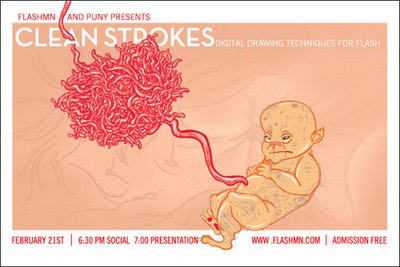
Minneapolis based animation and design studio PUNY (the new-media spin-off of Big Time Attic) presents "CLEAN STROKES: Digital Drawing Techniques For Flash." This presentation will feature various digital drawing techniques for creating art that is used in animation and video game art for clients like Cartoon Network and DC Comics. Presentation includes digital inking techniques for traditional artists using the inexpensive 4X6 Wacom Graphire tablet and a "sculpt and stroke" technique using the mouse. Extensive Q&A to answer particular questions about importing or creating art in Adobe Flash.
http://www.punyentertainment.com
When: February 21st 6:30 social 7:00 Presentation. Admission is free and open to the public. Free pizza and refreshments.
Where: FlashMN at Easel Training
More info and directions here: http://www.flashmn.com/

Minneapolis based animation and design studio PUNY (the new-media spin-off of Big Time Attic) presents "CLEAN STROKES: Digital Drawing Techniques For Flash." This presentation will feature various digital drawing techniques for creating art that is used in animation and video game art for clients like Cartoon Network and DC Comics. Presentation includes digital inking techniques for traditional artists using the inexpensive 4X6 Wacom Graphire tablet and a "sculpt and stroke" technique using the mouse. Extensive Q&A to answer particular questions about importing or creating art in Adobe Flash.
http://www.punyentertainment.com
When: February 21st 6:30 social 7:00 Presentation. Admission is free and open to the public. Free pizza and refreshments.
Where: FlashMN at Easel Training
More info and directions here: http://www.flashmn.com/
Ezekiel Fishman Versus the Martians: Part One
Steve Stwalley is online! Check out his first twelve pages of the 144 Hour Comic Challenge and give him mad props.
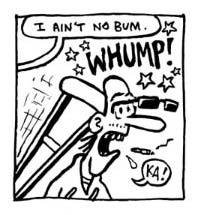
Read more about the 144 Hour Comic Challenge HERE.

Read more about the 144 Hour Comic Challenge HERE.
Cartooning Tips and Tricks: Guide to Creating a Panel
This post is for the beginning cartoonist who would like to see the creation of a panel demystified. This is by no means the "right" way to create a panel, just a detailed account of how I happened to create this particular panel. Click on the images for larger versions.

1. Figure out a few things before you draw: how big is the panel, how many word balloons will you need and where will they be placed? A thumbnail drawing is important here to work out your placement.
2. Rule your border with pencil. This panel is 3 in. x 3 in.
3. Rule your lettering guidelines. I don't use a professional guide, just a cheap plastic ruler. For whatever reason, I've found that I like having a 5 mm distance between lines. If your bubble is at the top of the panel, leave a 2 mm space from the top. If your bubble is on the bottom, leave a 3 mm space.
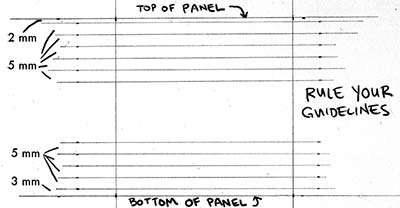
4. Figure out how your sentence will fit into the bubble before you draw anything. I like to scribble out a sample bubble on the script, making sure lines are the correct width. I try as much as possible not to break up words. If you have to break up a word, make the break at a logical point if you can (LOW-DOWN vs. LO-WDOWN), and try to break the word in between consonants (VER-NACULAR vs. VE-RNACULAR or VERNA-CULAR).
5. Pencil your letters. Keep a 1-2 mm space between the tops of your letters and the top line.
6. If you come to the end of the line, and you've either run out of space or have too much space, you can either erase and start over, or write a note to yourself at the beginning of the line (see below). I draw in arrows to tell me how to ink that particular line.
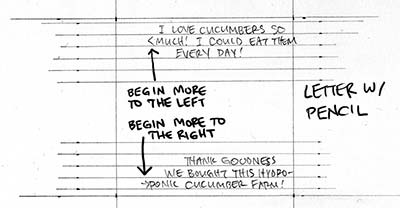
7. Ink your letters. For this exercise I'm using a Micron 05 for normal and Micron 08 for bold. I recommend keeping a piece of cardstock under your right hand during the whole lettering and inking process to prevent skin oils from getting on the page and to keep sweat from warping your paper. That tip is for right-handers only -- I don't know what you southpaws do.
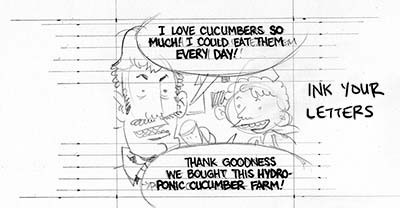
8. Pencil the rest of your drawing. Tightness is a personal preference, and will vary by project. If you're pencilling for yourself, and you're comfortable with your style, you can get away with loose pencils. If you're pencilling for someone else and you want them to ink it in a very specific way, then you need to put down very tight pencils.
9. Rule your borders. Here I used a Pigma Graphic 1 pen and a metal ruler with a raised edge. The raised edge will prevent the ink from bleeding underneath your ruler. If your ruler isn't raised, try taping something underneath, like cardboard or even coins.
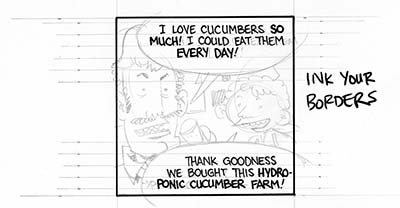
10. Ink the artwork. Here I used a Pentel Pocket brush pen.
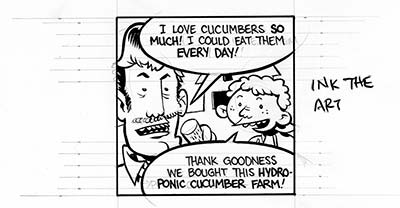
11. Erase the pencil lines. I recommend a kneaded eraser because you can make little sculptures with it. However, if you LOVE having millions of little crumbs everywhere, by all means use a regular eraser.
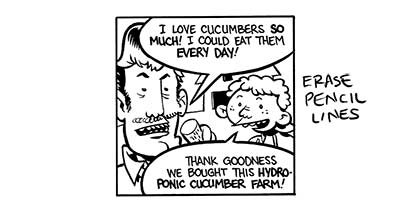
12. Scan and color. You're done.

1. Figure out a few things before you draw: how big is the panel, how many word balloons will you need and where will they be placed? A thumbnail drawing is important here to work out your placement.
2. Rule your border with pencil. This panel is 3 in. x 3 in.
3. Rule your lettering guidelines. I don't use a professional guide, just a cheap plastic ruler. For whatever reason, I've found that I like having a 5 mm distance between lines. If your bubble is at the top of the panel, leave a 2 mm space from the top. If your bubble is on the bottom, leave a 3 mm space.

4. Figure out how your sentence will fit into the bubble before you draw anything. I like to scribble out a sample bubble on the script, making sure lines are the correct width. I try as much as possible not to break up words. If you have to break up a word, make the break at a logical point if you can (LOW-DOWN vs. LO-WDOWN), and try to break the word in between consonants (VER-NACULAR vs. VE-RNACULAR or VERNA-CULAR).
5. Pencil your letters. Keep a 1-2 mm space between the tops of your letters and the top line.
6. If you come to the end of the line, and you've either run out of space or have too much space, you can either erase and start over, or write a note to yourself at the beginning of the line (see below). I draw in arrows to tell me how to ink that particular line.

7. Ink your letters. For this exercise I'm using a Micron 05 for normal and Micron 08 for bold. I recommend keeping a piece of cardstock under your right hand during the whole lettering and inking process to prevent skin oils from getting on the page and to keep sweat from warping your paper. That tip is for right-handers only -- I don't know what you southpaws do.

8. Pencil the rest of your drawing. Tightness is a personal preference, and will vary by project. If you're pencilling for yourself, and you're comfortable with your style, you can get away with loose pencils. If you're pencilling for someone else and you want them to ink it in a very specific way, then you need to put down very tight pencils.
9. Rule your borders. Here I used a Pigma Graphic 1 pen and a metal ruler with a raised edge. The raised edge will prevent the ink from bleeding underneath your ruler. If your ruler isn't raised, try taping something underneath, like cardboard or even coins.

10. Ink the artwork. Here I used a Pentel Pocket brush pen.

11. Erase the pencil lines. I recommend a kneaded eraser because you can make little sculptures with it. However, if you LOVE having millions of little crumbs everywhere, by all means use a regular eraser.

12. Scan and color. You're done.
Monday, February 19, 2007
144 Hour Comic Challenge
Zander and Steve Stwalley and I commenced the 144 Hour Graphic Novel Challenge on Saturday. Sadly, I didn't get any photos of Steve, but trust me, he was totally there.
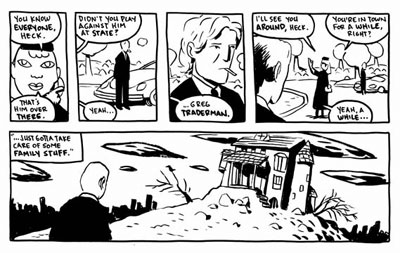
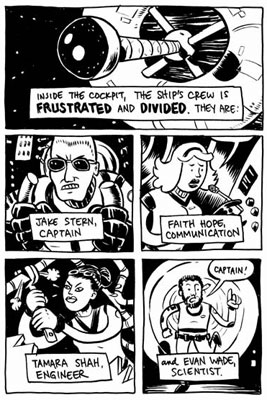
* Read Chapter One Online! *
As you've probably guessed, the 144 Hour Challenge is like the 24 Hour challenge, but is a little more sane -- 12 page in 12 hours, once a month for a year. The Cartoonist Conspiracy already holds an open jam time once a month at the Minnesota Center for Book Arts, so everyone can hang out and draw together, even if you're not doing the Challenge.
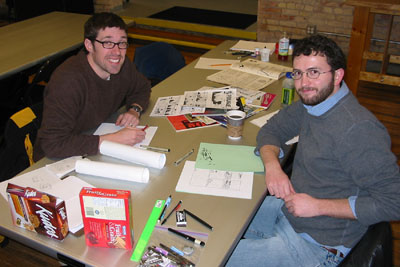
Zander and I scheduled our first shift to correspond with the MCBA's coffee shop hours, which also lasts twelve hours. We showed up at 8 am and worked until noon, when we moved over to the jam table in the MCBA work room. Steve showed up to start his noon-midnight shift. Other cartoonists in attendance were David Steinlicht, Mike Toft, and Mark Simonson. When the monthly jam wrapped up, Zander, Steve, and I marched back to the coffee shop to wrap up Chapter One.
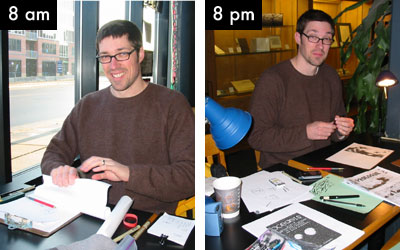


* Read Chapter One Online! *
As you've probably guessed, the 144 Hour Challenge is like the 24 Hour challenge, but is a little more sane -- 12 page in 12 hours, once a month for a year. The Cartoonist Conspiracy already holds an open jam time once a month at the Minnesota Center for Book Arts, so everyone can hang out and draw together, even if you're not doing the Challenge.

Zander and I scheduled our first shift to correspond with the MCBA's coffee shop hours, which also lasts twelve hours. We showed up at 8 am and worked until noon, when we moved over to the jam table in the MCBA work room. Steve showed up to start his noon-midnight shift. Other cartoonists in attendance were David Steinlicht, Mike Toft, and Mark Simonson. When the monthly jam wrapped up, Zander, Steve, and I marched back to the coffee shop to wrap up Chapter One.

Friday, February 16, 2007
Influences: The Muppets
Like many toddlers growing up in the early eighties, much of my time was spent on Sesame Street, hanging out with Jim Henson's muppets. But while Henson and his crew were overtly interested in teaching kids their letters and numbers, I was getting my first lesson in cartooning. That is, by studying the muppets' exaggerated and simplified puppet faces, I learned that very simple changes in facial structure could evoke wildly different emotions.
This effect is strongest in Bert, the lanky, banana-hued muppet whose eyebrows seem to do all the talking. I didn't realize it at the time, but Bert (through Henson's puppeteers) was teaching me that you didn't have to draw a realistic human face to capture realistic human emotion.
Try out this little Flash widget to see what I mean.
Coicidentally, my mom makes her living teaching and writing about emotions, so I was fortunate to grow up with a library of books about emotions and cognition. One author who stuck out -- and who every cartoonist should be familiar with -- is Paul Ekman. Ekman has spent his life cataloguing the amazing range of human emotions, face by face.
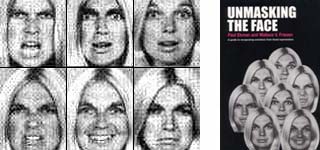
For a cartoonist, one of the fascinating aspects of Ekman's research is how easily these changes in facial expressions can be represented by the angle of a line (a mouth or an eyebrow) or their proximity to one another (eyebrow to eye, mouth to nose).
While we're on the subject of cartooning and faces, let me throw some questions into the ether. A long time ago I noticed that when I'm drawing characters, especially while drawing their faces, I sometimes catch myself making the same face. The more I noticed this subconscious act happening, the more I believed that it was helping me draw. For some reason making an angry face helped me draw an angry character, smiling helped draw a happy character, etc. So my first question is, has anyone else noticed themselves doing it? (Or am I just insane? -- the two may not be mutually exclusive...) And the second question is this: Do we make these faces proactively, i.e. I smile first so that I may get into my character's emotional state and therefore draw him better, or do I smile reactively, i.e. I smile in response to something I have put down on the page?
With all the current research into mirror neurons, I think that my making a face while drawing is reactive. However, I don't think that I'm smiling in reaction to the smiling face on the page, because often I'll smile before anything solid is put down on paper. I think I'm actually smiling in response to the thought of a person smiling, which must necessarily exist before I draw anything.
Links:
Paul Ekman at SharpBrains.com
Paul Ekman at Wikipedia
Mirror neurons at Wikipedia
Mirror neurons at MindHacks.com
This effect is strongest in Bert, the lanky, banana-hued muppet whose eyebrows seem to do all the talking. I didn't realize it at the time, but Bert (through Henson's puppeteers) was teaching me that you didn't have to draw a realistic human face to capture realistic human emotion.
Try out this little Flash widget to see what I mean.
Coicidentally, my mom makes her living teaching and writing about emotions, so I was fortunate to grow up with a library of books about emotions and cognition. One author who stuck out -- and who every cartoonist should be familiar with -- is Paul Ekman. Ekman has spent his life cataloguing the amazing range of human emotions, face by face.

For a cartoonist, one of the fascinating aspects of Ekman's research is how easily these changes in facial expressions can be represented by the angle of a line (a mouth or an eyebrow) or their proximity to one another (eyebrow to eye, mouth to nose).
While we're on the subject of cartooning and faces, let me throw some questions into the ether. A long time ago I noticed that when I'm drawing characters, especially while drawing their faces, I sometimes catch myself making the same face. The more I noticed this subconscious act happening, the more I believed that it was helping me draw. For some reason making an angry face helped me draw an angry character, smiling helped draw a happy character, etc. So my first question is, has anyone else noticed themselves doing it? (Or am I just insane? -- the two may not be mutually exclusive...) And the second question is this: Do we make these faces proactively, i.e. I smile first so that I may get into my character's emotional state and therefore draw him better, or do I smile reactively, i.e. I smile in response to something I have put down on the page?
With all the current research into mirror neurons, I think that my making a face while drawing is reactive. However, I don't think that I'm smiling in reaction to the smiling face on the page, because often I'll smile before anything solid is put down on paper. I think I'm actually smiling in response to the thought of a person smiling, which must necessarily exist before I draw anything.
Links:
Paul Ekman at SharpBrains.com
Paul Ekman at Wikipedia
Mirror neurons at Wikipedia
Mirror neurons at MindHacks.com
Subscribe to:
Comments (Atom)

